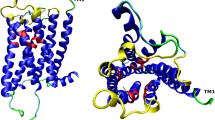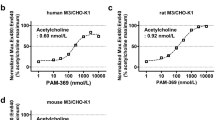Summary
The non-selective labelled antagonist [3H]N-methyl-scopolamine ([3H]NMS) was used to identify muscarinic acetylcholine receptors in rat duodenum smooth muscle membranes. Saturation and kinetic experiments revealed a binding site with a KD-value of 0.2–0.3 nmol/l and a receptor concentration (Bmax) of 100 fmol/mg protein. The affinities of eight selective muscarinic antagonists were determined and compared with those at M1 (rat cerebral cortex), M2 (rat heart), M3 (rat submandibular gland) and M4 (data from Dörje et al. 1991) receptors. The “M2-selective” agent AF-DX 116, the group of “M2/M4-selective” compounds himbacine, AF-DX 384, AQ-RA 741 and methoctramine but also the “M3-selective” HHSiD showed affinities corresponding to M2 and/or M4 sites. The intermediate affinity of 4-DAMP favours a mixed M2/M4 receptor population mainly containing M2 receptors. Two compounds, pirenzepine and AQ-RA 741, displayed biphasic displacement curves indicating the presence of a small population of putative M1 receptors. The rat duodenum antagonist binding profile, however, is not consistent with the presence of M3 receptors. We further demonstrate a concentration-dependent stimulation of [35S]GTP[S] binding to duodenal G proteins by the muscarinic agonist oxotremorine. Estimation of the binding parameters of GTP[S] in absence and presence of oxotremorine provided evidence for a catalytic activation of G proteins by agonist-activated muscarinic receptors in rat duodenal membranes and a strong signal amplification on the G protein level.
Similar content being viewed by others
References
Birnbaumer L, Abramowitz J, Brown AM (1990) Receptor-effector coupling by G proteins. Biochim Biophys Acta 1031:163–224
Cheng YC, Prusoff WH (1973) Relationship between the inhibition constant (K1) and the concentration of inhibitor which causes 50 per cent inhibition (IC50) of an enzymatic reaction. Biochem Pharmacol 22: 3099 - 3108
Dörje F, Friebe G, Tacke R, Mutschler E, Lambrecht G (1990) Novel pharmacological profile of muscarinic receptors mediating contraction of the guinea-pig uterus. NaunynSchmiedeberg's Arch Pharmacol 342:284–289
Dörje F, Wess J, Lambrecht G, Tacke R, Mutschler E, Braun MR (1991) Antagonist binding profiles of five cloned human muscarinic receptor subtypes. J Pharmacol Exp Ther 256: 727–733
Eglen RM, Michel AD, Whiting RL (1989) Characterization of the muscarinic receptor subtype mediating contractions of the guinea-pig uterus. Br J Pharmacol 96:497–499
Ghodshi-Hovsepian S, Messer WS, Hess W (1990) Differential coupling between muscarinic receptors and G proteins in regions of the rat brain. Biochem Pharmacol 39:1385–1391
Giachetti A, Micheletti R, Montagna E (1986) Cardioselective profile of ADF-DX 116, a muscarinic M2 receptor antagonist. Life S638:1663–1672
Giraldo E, Vigano MA, Hammer R, Ladinsky H (1988) Characterization of muscarinic receptors in guinea pig ileum longitudinal smooth muscle. Mol Pharmacol 33:617–625
Hammer R, Berri CP, Birdsall NJM, Burgen ASV, Hulme EC (1980) Pirenzepine distinguishes between different subclasses of muscarinic receptors. Nature 283:90–92
Hammer R, Giraldo E, Schiavi GB, Monferini E, Ladinsky H (1986) Binding profile of a novel cardioselective muscarinic receptor antagonist, AF-DX 116, to membranes of peripheral tissues and brain in the rat. Life Sci 38:1653–1662
Hilf G, Gierschik P, Jakobs KH (1989) Muscarinic acetylcholine receptor-stimulated binding of guanosine 5′-o-(3-thiophos-phate) to guanine-nucleotide-binding proteins in cardiac membranes. Eur J Biochem 186:725–731
Hulme EC, Birdsall NJM, Buckley NJ (1990) Muscarinic receptor subtypes. Ann Rev Pharmacol Toxicol 30:633–673
Ladinsky H, Giraldo E, Monferini E, Schiavi GB, Vigano MA, De Conti L, Micheletti R, Hammer R (1988) Muscarinic receptor heterogeneity in smooth muscle: binding and functional studies with AF-DX 116. Trends Pharmacol Sci [Suppl] 44–48
Lambrecht G, Feifel R, Wagner-Röder M, Strohmann C, Zilch H, Tacke R, Waelbroeck M, Christophe J, Boddecke H, Mutschler E (1989) Affinity profiles of hexahydro-sila-difenidol analogues at muscarinic receptor subtypes. Eur J Pharmacol 168: 71–80
Lazareno S, Buckley NJ, Roberts FF (1990) Characterization of muscarinic M4 binding sites in rabbit lung, chicken heart, and NG 108–15 cells. Mol Pharmacol 38:805–815
Lowry OH, Rosebrough NJ, Farr AL, Randall RJ (1951) Protein measurement with the Folin phenol reagent. J Biol Chem 193:265–275
Michel AD, Whiting RL (1989) Radioligand binding characteristics of the chicken cardiac muscarinic receptor. NaunynSchmiedeberg's Arch Pharmacol 340:279–284
Micheletti R, Schiavone A (1990) Functional determination of McN-A-343 affinity for M1 muscarinic receptors. J Pharmacol Exp Ther 253:310–314
Micheletti R, Schiavone A, Giachetti A (1988) Muscarinic M1 receptors stimulate a nonadrenergic noncholinergic inhibitory pathway in the isolated rat duodenum. J Pharmacol Exp Ther 244:680–684
Micheletti R, Gindici L, Turconi M, Donetti A (1990) 4-DAMP analogues reveal heterogeneity of M1 muscarinic receptors. Br J Pharmacol 100:395–397
Mitchelson F (1988) Muscarinic receptor differentiation. Pharmacol Ther 37:357–423
Munson PJ, Rodbard D (1980) LIGAND: A versatile approach for the characterization of ligand binding systems. Anal Biochem 107:220–239
Pedder EK, Eveleigh P, Poyner D, Hulme EC, Birdsall NJM (1991) Modulation of the structure-binding relationships of antagonists for muscarinic acetylcholine receptor subtypes. Br J Pharmacol 103:1561–1567
Scatchard G (1949) Attractions of proteins for small molecules and ions. Ann NY Acad Sci 51:660–679
Tobler HJ, Engel G (1983) Affinity spectra: A novel way for the evaluation of equilibrium binding experiments. Naunyn-Schmiedeberg's Arch Pharmacol 322:183–192
Waelbroeck M, Tastenoy M, Camus J, Christophe J (1990) Binding of selective antagonists to four muscarinic receptors (M1 to M4) in rat forebrain. Mol Pharmacol 38:267–273
Weiner D, Levey A, Braun MR (1990) Expression of muscarinic acetylcholine and dopamine receptor mRNA's in rat basal ganglia. Proc Natl Acad Sci USA 87:7050–7054
Author information
Authors and Affiliations
Additional information
Send offprint requests to C. Liebmann at the above address
Rights and permissions
About this article
Cite this article
Liebmann, C., Nawrath, S., Schnittler, M. et al. Binding characteristics and functional G protein coupling of muscarinic acetylcholine receptors in rat duodenum smooth muscle membranes. Naunyn-Schmiedeberg's Arch Pharmacol 345, 7–15 (1992). https://doi.org/10.1007/BF00175462
Received:
Accepted:
Issue Date:
DOI: https://doi.org/10.1007/BF00175462




